My last post was sad, so I think we need a happy post to balance it, so here’s a throwback to my visit to Europe in 2023. One of the things I was told by Swedish friends in New Zealand that I absolutely must do whilst in Stockholm was to go to Skansen.
Luckily Elisa fully agreed with them!

Skansen is the world’s oldest open air museum. It helped inspire places like Colonial Williamsburg, and is so iconic that ‘skansen’ is literally the word for an open air museum in Czech.
It features buildings from different eras from all across Sweden. Some of the buildings are only viewable from the outside, but other are open on some days, so you can go inside.
The open buildings have docents in clothes matching the era and type of building doing work in keeping with the building. All of the docents had a particular interest and expertise related to the building and its purpose. It was fabulous. Nerdling that I am I asked the hosts 18 gazillion questions.
Here’s some of what I saw:
An 18th century milestone (literally!) and a tall wooden belfry built in 1732-33

The belfry has been coated with tar coloured red with falu red pigment. The tar helps preserve the wood, and the red is more attractive than the standard tar colour.

A storehouse for food. What really struck me about this is how many similarities there are between this style of storehouse, and traditional Māori storehouses.


The High Loft and the New Loft, in ‘National Romantic’ style:
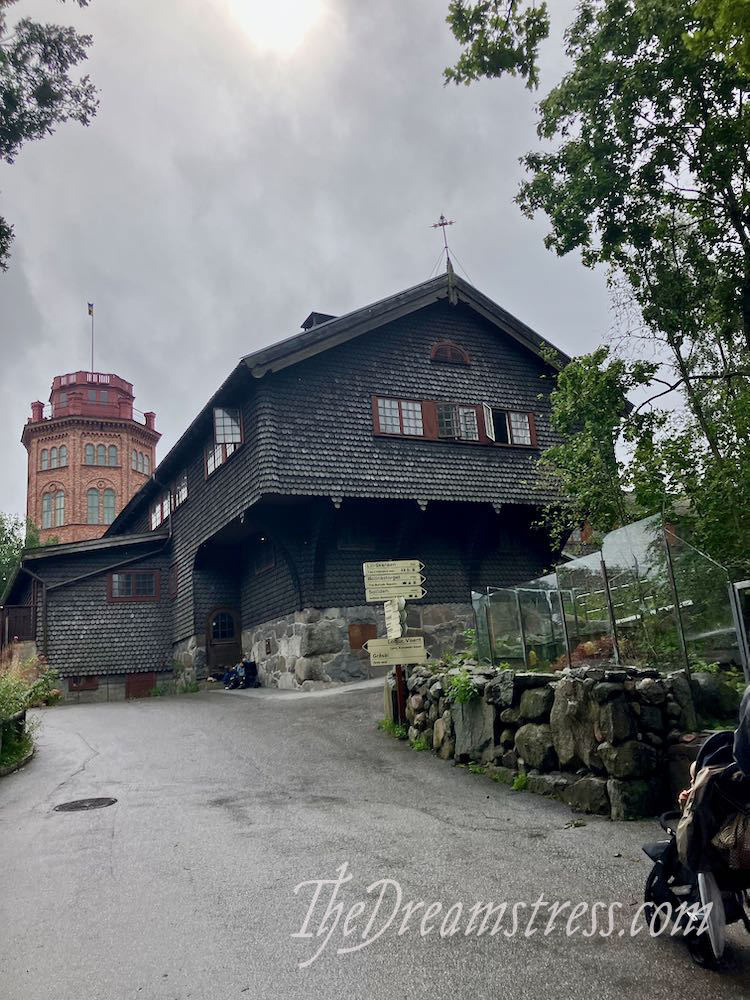


The first building we got to go in was the apothecary, and what a corker of a place to start!

It featured a taxidermy crocodile (I think it’s actually a caiman), without which no 18th century Swedish apothecary was complete!

The docent host portrayed the apothecary’s wife, as women weren’t allowed to be apothecaries in their own right. However, as most apothecaries were family businesses, it’s likely the wives did lots of dispensing and helping.
She had some 18th century apothecary mixes for us to smell. Notice that the expectorant is ‘sin opium’ (without opium).
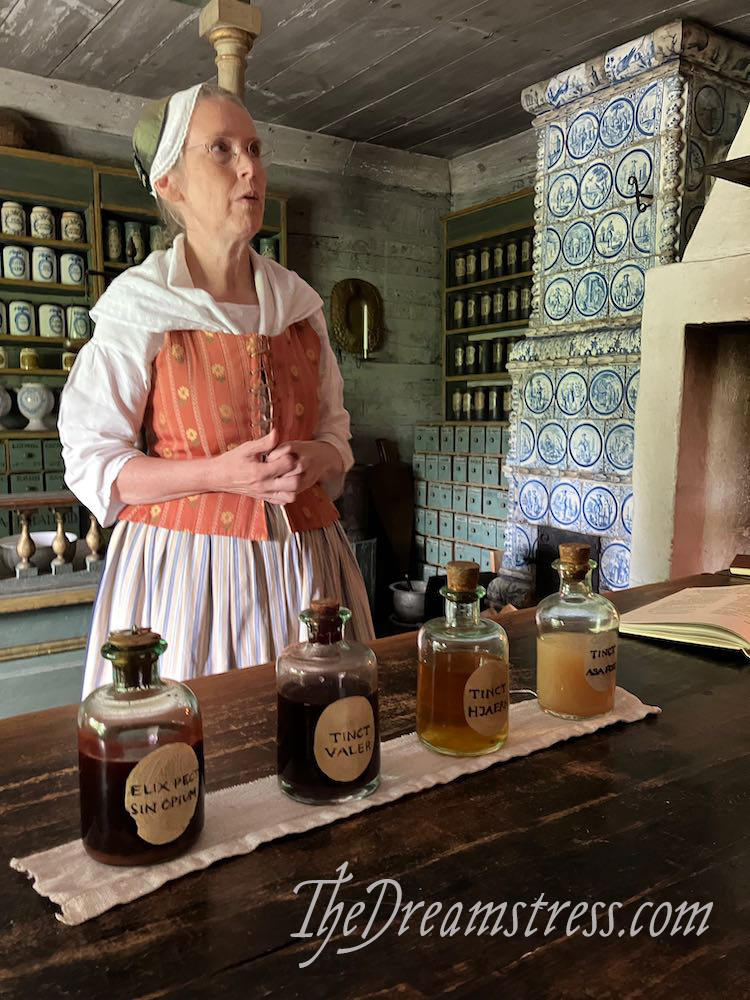
Look at the gorgeous tile stove! And all those beautiful bottles and drawers!

In the next room was equipment for distilling tinctures, drafting draughts and pulverising powders (tiny attempt at a Swedish pun – powder is ‘pulver’ in Swedish).

In the final room was the apothecary’s apprentice, busy making pastils in the 18th century manner:

His pastils were made from clay, to imitate the texture of an 18th century pastil without including any of the real ingredients, mummy powder having (thankfully!) fallen out of favour as a medicine.

In addition to buildings, the grounds of Skansen were full of plants & gardens specific to different areas and eras:

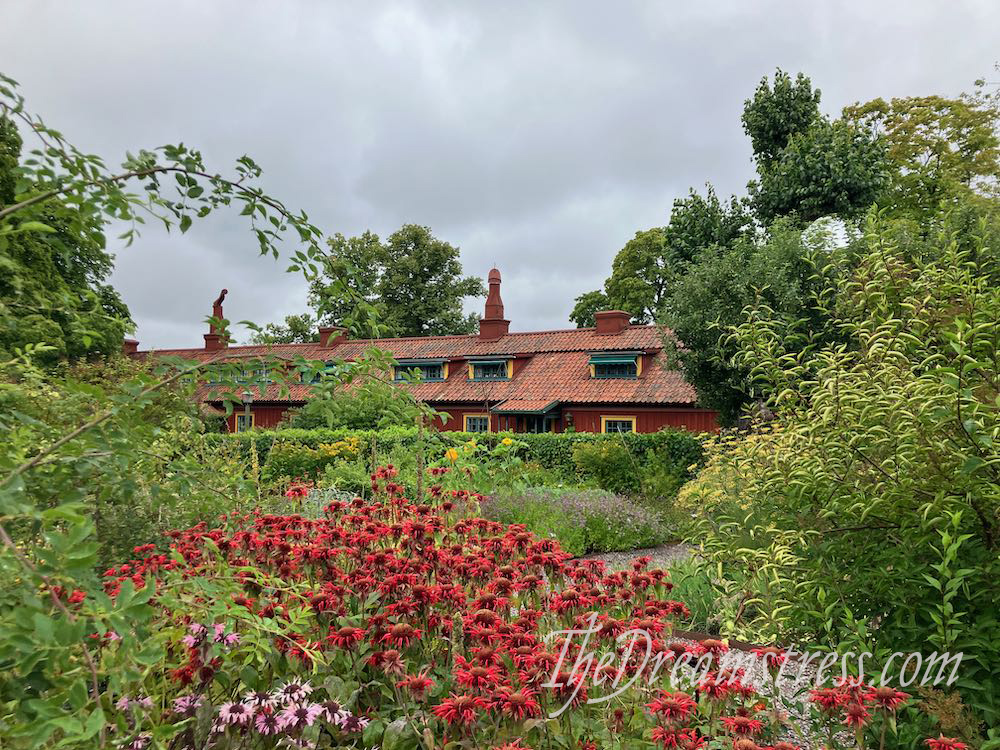
And the ubiquitous and inevitable Canadian geese, those repositories of all the anger and rudeness that got drained out of the Canadian people:
(ETA: turns out they are barnacle geese! See second photo & comments. However, I’m leaving the Canadian geese comment, because people enjoyed it and there are/were Canadian geese at Skansen, just not in these photos)


The next stop was a modest 19th century farmhouse:



Inside I got to try turnip for the first time (you don’t get a lot of turnips in Hawai’i!), and had a fascinating discussion with the docents about living history and culture.
Check out these double-decker curtained beds, helpful for keeping snug in the Swedish winter:
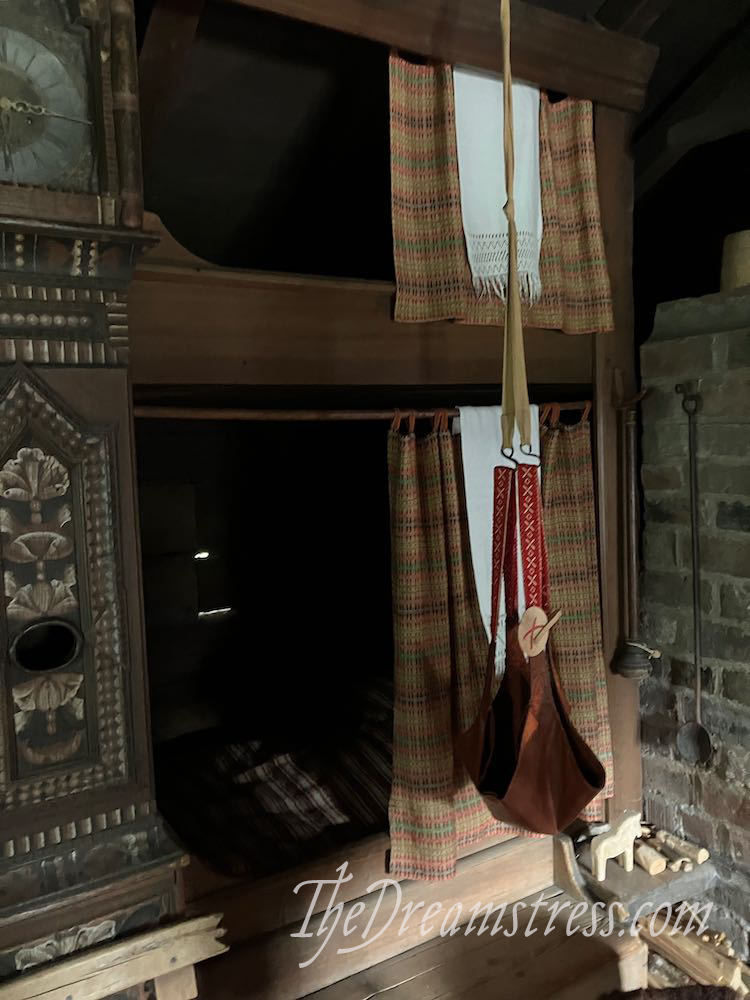
And these cunning birch shoes:

On the recommendation of the hosts in this house we headed off to the ladies summer house for cheesemaking:

It’s the ladies summer house because in some parts of Sweden it was the job of the unmarried women to take the cows up the mountains to their summer grazing lands, and to make cheese and butter while having a (hopefully lovely) women’s only retreat.

They were making mesost or messmör, a caramelised whey cheese. I did not get the to try the cheese, but Elisa offered to buy some for me, with the warning that she didn’t care for the type personally, and the closest description she could give of it was ‘peanut butter cheese’.
Having finally had the opportunity to try brunost (the Norwegian style of whey cheese) this year, I can see what she meant. I liked it, but it also completely confused my brain, which felt that cheese should not be sweet and peanut butter-y. As long as I thought of it as ‘caramelised reduced dairy spread’ my brain agreed it was delicious.


Then, past the manor house, and on to more food! Only this time we didn’t get to eat it, just admire:

The manor house kitchen house had a spread of 18th century food of the type that might have been served at the manor house. I hope someone got to eat some of this because it looks delicious!




The kitchen house also had the servants quarters:

And a dining room with the most amazing hand-painted wallpaper:

From food, to finery. We went up an exciting set of death stairs to see a jeweller at work.


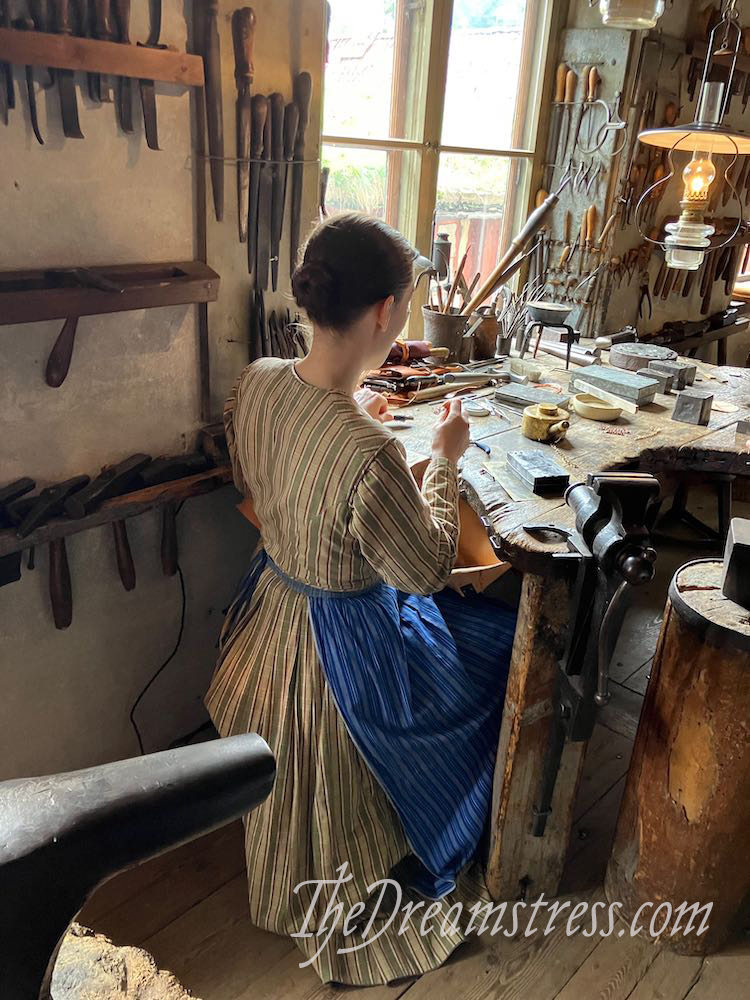
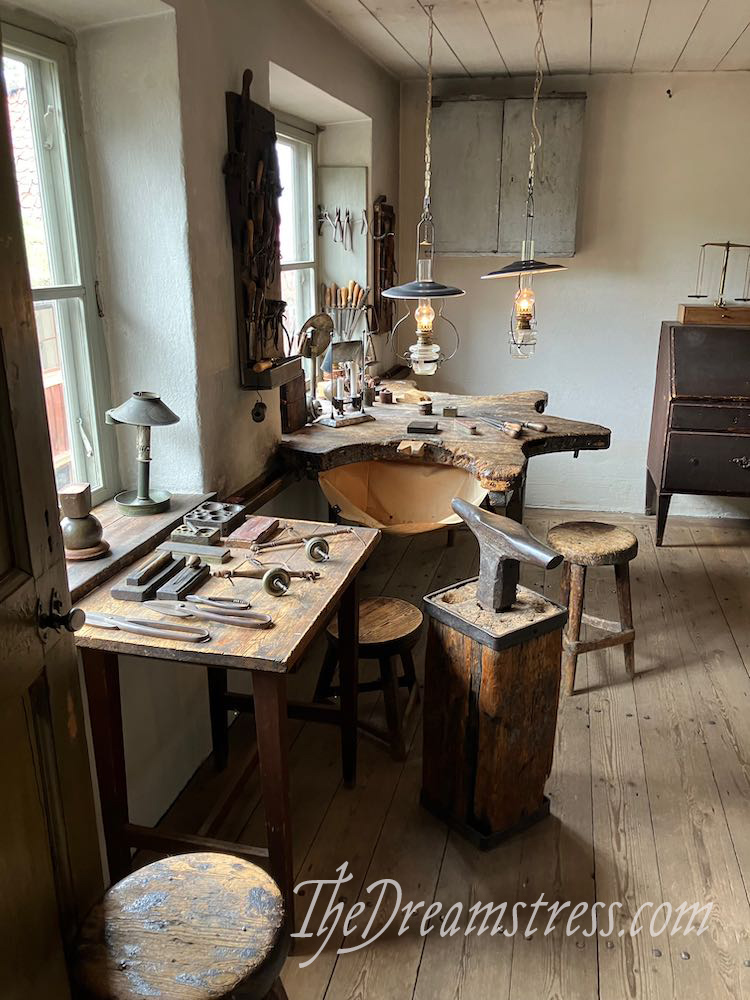
And that’s only 1/8th of what we saw. What a fabulous day!

What a fabulous visit, it looks so fun! So much wonderful detail in the apothecary.
I think the geese might actually be barnacle geese – which I mention because they have a great historical component to their name that I think you’d like. Before we knew about migration, people used to think (among other things) they turned into gooseneck barnacles over the winter! The wiki article “barnacle goose myth” has several thousand years of debate on the topic…
Yes, those are definitely barnacle geese – they have the white that comes up towards their faces and the black neck and bib whereas Canada geese only have black necks and the white on their heads doesn’t come so far forwards. Barnacle geese are also a bit smaller and more delicate. (Bean geese look similar to barnacle geese but are extremely shy, so not going to be hanging out in a museum.)
That said, that description of Canada geese is so hilarious and perfect, I’m glad this mix-up happened so I could read it!
Re: Geese – I got intrigued. They’re foreign to Czechia, although they do occasionally show up – but it’s a rare sight and I don’t think I’ve ever seen them. So apparently they’re related and the main obvious difference is their size. If these were in the 50-70 cm range, they were barnackle geese; if they were more around a meter, they’re Canadian geese. Either is possible at this locale, according to Wikipedia. 🙂
It’s Candian geese. They started out as part of Skansen’s zoo, but has now spread to the whole island Skansen is located at. They are rather and nuisance, especially for people working at Skansen. I used to work there as a cleaner during summers, and was attacked more than once. They are nasty birds.
I think Erin is right! Looking at my other photos, these definitely match Barnacle geese not Canadian geese. But you are right there are Canadian geese at Skansen, just not the ones I captured in these photos. I guess that’s why these ones were so nice when I just walked right through them
What a fabulous visit, it looks so fun! So much wonderful detail in the apothecary.
I think the geese might actually be barnacle geese – which I mention because they have a great historical component to their name that I think you’d like. Before we knew about migration, people used to think (among other things) they turned into gooseneck barnacles over the winter! The wiki article “barnacle goose myth” has several thousand years of debate on the topic…
that apothecary room has my heart…i long for a home apothecary in grand antiquated style. actually quite useful, too, apart from taxidermied reptiles.
looks like an amazing time. skansen has been on my list for ages. one day!
There’s so much to comment on that I’m not sure I’m even going to try. 😀
Falun red! Iconic.
I love the literal milestone.
And that type of shoes actually plays a role in Czech legends! Or something similar. Přemysl the legendary founder of the Přemyslid dynasty wore a pair of tree bast shoes before he became the prince. Apparently they were part of the coronation ritual until the 14th century. Once upon a time they must have been a thing all over Europe, or at least most of it, among rural working classes. The Czech National Museum has some from I believe Ukraine that look just like these – alas, the coronation ones did not survive.
And the apothekary reminded me of the one they have in Kačina here… That one is newer, I think, and they did not demonstrate anything, but amused me greatly with having a jar labelled something in Latin that translated to I think “spirit of Jamaica” – aka rum! Lots of eyebrow-raising ingredients in the apothekaries of the past. 😀
As a kid I never wanted to go to Skansen when we were in Stockholm, I didn’t see the point in going to the same kind of houses that were everywhere at home. The national romantic movement took most of its inspiration from my region, so that High and New loftet are more or less copies of a standing 16th century house here and we still have those kinds of storage houses standing around in the landscape. Of course today I enjoy the interaction with the docents and can enjoy a visit to Skansen even if I still don’t care too much about the houses.
Thank you for the tour! I used to work as a “doctor’s housekeeper” in a Victorian-era open-air museum in Canada. It was a lot of fun. Well, we were not re-enactors, so I wasn’t really acting like the doctor’s housekeeper but rather if asked, that’s who I’d say I was dressed as. I loved showing off the medical tools.
I know in our museum, there was lots of gorgeous food on display, especially before Christmas. It was either high-quality plastic and resin, or made from salt-dough. It was very, very convincing.
Haha, your comment about the Canadian geese is uproarious!
Now I’m wondering, what was the purpose of a taxidermy crocodile/caiman? It definitely caught my eye when I saw this post!
Thank you for posting all these photos, Skansen is amazing!